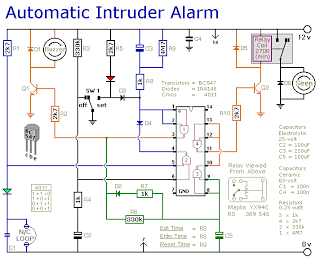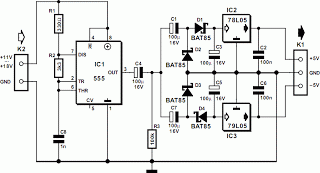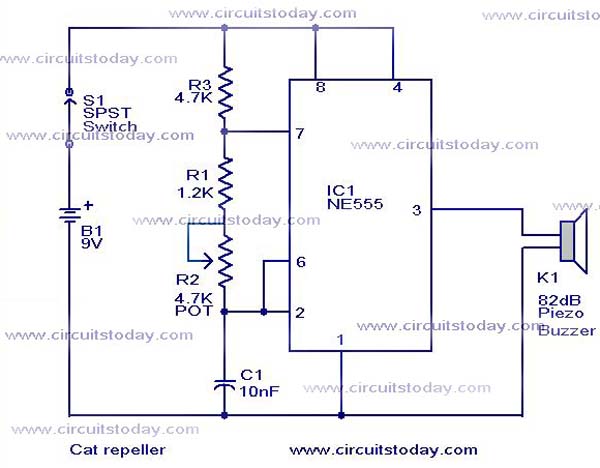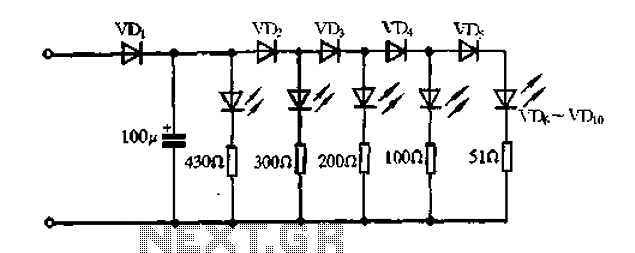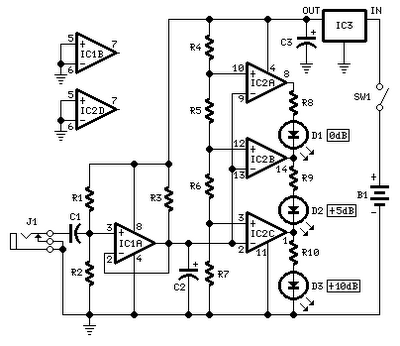
555 IC Water Level Sensor/Detector Alarm
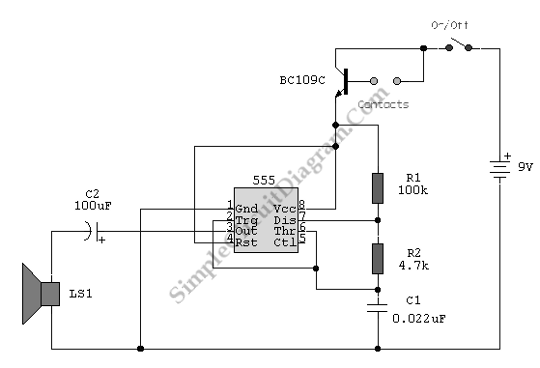
This schematic diagram illustrates a 555 IC water level sensor and detector alarm circuit. The circuit is powered by the emitter current of the BC109C transistor. The 555 timer operates as an astable oscillator in this configuration. Under dry conditions, the transistor remains completely off due to a lack of bias current. When the probes become wet, a small current flows between the emitter and base, activating the transistor. This allows the 555 oscillator to function and produce sound as a larger current flows through the collector circuit. The schematic includes an On/Off switch, and it is recommended to use non-reactive metals for the probe contacts, such as gold or silver-plated contacts from an old relay. A cost-effective alternative is to use copper strips from a piece of veroboard, although these will oxidize over time. The increased impedance from oxidation is not significant since very little current flows in the base circuit. The transistor operates in an emitter follower configuration, eliminating the need for a base resistor, with the current limited by the impedance at the emitter.
The circuit also features an alarm system capable of detecting any fluid with a resistance below 900K ohms between the maximum separation distance of the probes. A 4050B CMOS hex inverter is utilized to produce oscillation and detect the water level. This oscillation provides an alternating current (AC) source for the probe electrodes, which helps to prevent corrosion. Additionally, the MAXQ3210 is a powerful RISC microcontroller that supports battery-powered applications, enabling it to detect conditions and activate an alarm. The design includes a piezoelectric horn driver, a voltage regulator (5V to 9V), and an analog voltage comparator for enhanced functionality. Furthermore, the circuit can serve as a hot water level indicator, utilizing thermistors (NTC1-4) as sensors placed strategically to monitor the level of hot water in a tank. Another application of this technology is in a low-light level drop detector, which employs a self-biasing configuration to detect minute changes in light levels, commonly used in monitoring very low droplet rates. The collector of the transistor provides feedback that enhances the circuit's responsiveness to environmental changes.This schematic diagram below shows a 555 IC water level sensor/detector alarm circuit. This circuit is powered through the emitter current of the BC109C. 555 timer is used as astable oscillator in this circuit. When this circuit is under dry conditions the transistor will be fully off because it have no bias current. when the probes get wet, a sma ll current flows between emitter and base then the transistor switches on. The 555 osillator is enabled to sound because of a larger current flows in the collector circuit. Here is the schematic diagram of the circuit: An On/Off switch is provided and use a non-reactive metal for the probe contacts. We can use Gold or silver plated contacts from an old relay. But, a cheap alternative is to wire alternate copper strips from a piece of veroboard. These will eventually oxidize over, but the higher impedance caused by oxidization is not important because very little current is flowing in the base circuit.
the transistor is in emitter follower, so no base resistor is necessary. The current limit being the impedance at the emitter. [Circuit`s schematic diagram source: This schematic diagram shows a water level sensor/detector/monitor circuit. An alarm is also featured in this circuit. Any fluid with a resistance under 900K between the maximum separation distance of the probes will trigger this circuit.
A 4050B CMOS hex Continue reading †’. This water level sensor (detector) circuit uses a standard NAND logic gate to produce oscillation and to detect the water level. Oscillation is included inside this circuit to provide alternating current (AC) source for probe electrodes, to achieve a corrosion Continue reading †’.
The MAXQ3210 ia a powerful RISC microcontroller. This device have features and capabilities to make it compatible for battery-powered applications that detect a condition and sound on alarm. Piezoelectric horn driver, 5V to 9V regulator, and analog voltage comparator support Continue reading †’.
This is Hot Water Level Indicator circuit. This circuit can be used to monitor level of hot water in a tank. This circuit is simple and inexpensive. this circuit uses thermistors NTC1-4 as the sensor that is placed spread over Continue reading †’. This is a circuit of Low-Light Level Drop Detector. This circuit utilize self-biasing configuration to detect small changes in light level. This circuit usually used in monitoring very low droplets rates. The collector of the transistor gives feedback that is Continue reading †’. 🔗 External reference
The circuit also features an alarm system capable of detecting any fluid with a resistance below 900K ohms between the maximum separation distance of the probes. A 4050B CMOS hex inverter is utilized to produce oscillation and detect the water level. This oscillation provides an alternating current (AC) source for the probe electrodes, which helps to prevent corrosion. Additionally, the MAXQ3210 is a powerful RISC microcontroller that supports battery-powered applications, enabling it to detect conditions and activate an alarm. The design includes a piezoelectric horn driver, a voltage regulator (5V to 9V), and an analog voltage comparator for enhanced functionality. Furthermore, the circuit can serve as a hot water level indicator, utilizing thermistors (NTC1-4) as sensors placed strategically to monitor the level of hot water in a tank. Another application of this technology is in a low-light level drop detector, which employs a self-biasing configuration to detect minute changes in light levels, commonly used in monitoring very low droplet rates. The collector of the transistor provides feedback that enhances the circuit's responsiveness to environmental changes.This schematic diagram below shows a 555 IC water level sensor/detector alarm circuit. This circuit is powered through the emitter current of the BC109C. 555 timer is used as astable oscillator in this circuit. When this circuit is under dry conditions the transistor will be fully off because it have no bias current. when the probes get wet, a sma ll current flows between emitter and base then the transistor switches on. The 555 osillator is enabled to sound because of a larger current flows in the collector circuit. Here is the schematic diagram of the circuit: An On/Off switch is provided and use a non-reactive metal for the probe contacts. We can use Gold or silver plated contacts from an old relay. But, a cheap alternative is to wire alternate copper strips from a piece of veroboard. These will eventually oxidize over, but the higher impedance caused by oxidization is not important because very little current is flowing in the base circuit.
the transistor is in emitter follower, so no base resistor is necessary. The current limit being the impedance at the emitter. [Circuit`s schematic diagram source: This schematic diagram shows a water level sensor/detector/monitor circuit. An alarm is also featured in this circuit. Any fluid with a resistance under 900K between the maximum separation distance of the probes will trigger this circuit.
A 4050B CMOS hex Continue reading †’. This water level sensor (detector) circuit uses a standard NAND logic gate to produce oscillation and to detect the water level. Oscillation is included inside this circuit to provide alternating current (AC) source for probe electrodes, to achieve a corrosion Continue reading †’.
The MAXQ3210 ia a powerful RISC microcontroller. This device have features and capabilities to make it compatible for battery-powered applications that detect a condition and sound on alarm. Piezoelectric horn driver, 5V to 9V regulator, and analog voltage comparator support Continue reading †’.
This is Hot Water Level Indicator circuit. This circuit can be used to monitor level of hot water in a tank. This circuit is simple and inexpensive. this circuit uses thermistors NTC1-4 as the sensor that is placed spread over Continue reading †’. This is a circuit of Low-Light Level Drop Detector. This circuit utilize self-biasing configuration to detect small changes in light level. This circuit usually used in monitoring very low droplets rates. The collector of the transistor gives feedback that is Continue reading †’. 🔗 External reference
Warning: include(partials/cookie-banner.php): Failed to open stream: Permission denied in /var/www/html/nextgr/view-circuit.php on line 713
Warning: include(): Failed opening 'partials/cookie-banner.php' for inclusion (include_path='.:/usr/share/php') in /var/www/html/nextgr/view-circuit.php on line 713
